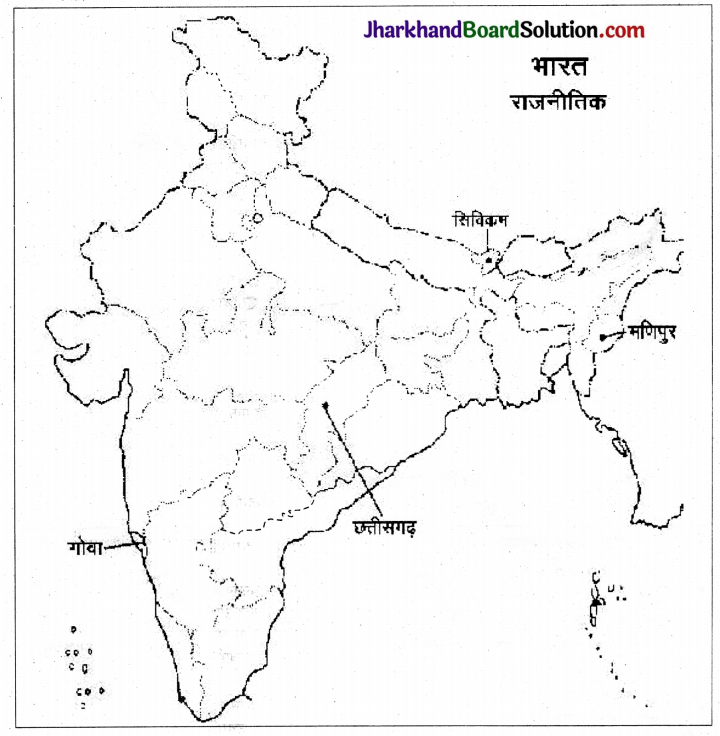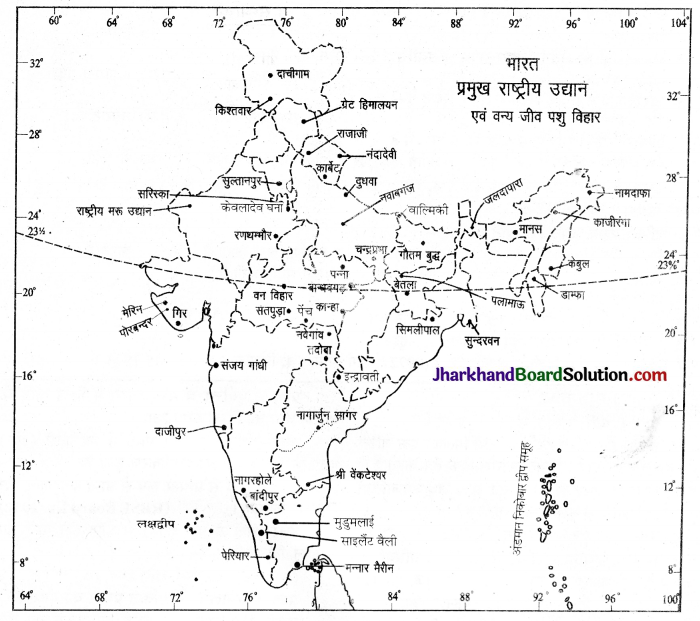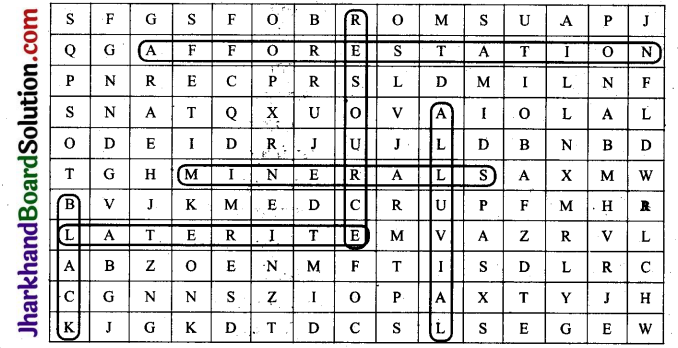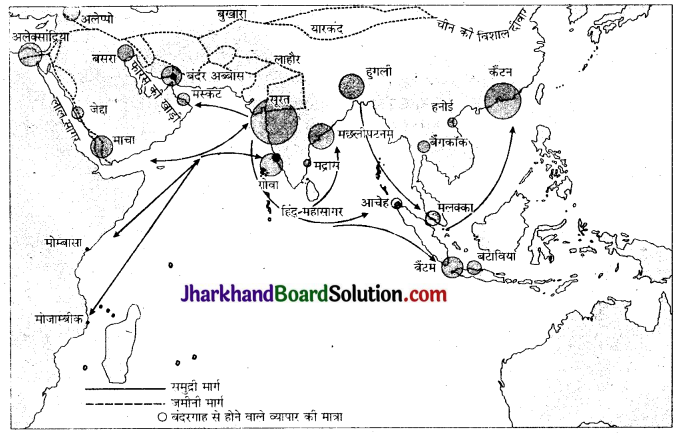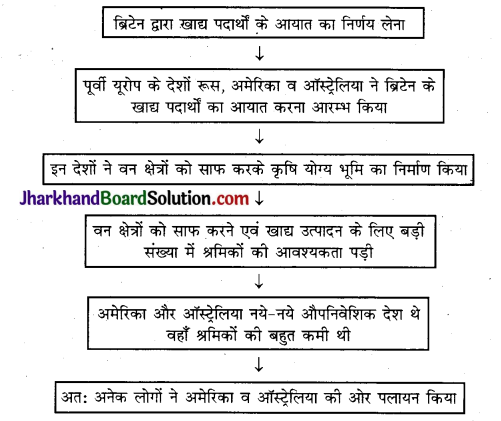JAC Board Class 10th Social Science Solutions Civics Chapter 4 जाति, धर्म और लैंगिक मसले
JAC Class 10th Civics जाति, धर्म और लैंगिक मसले Textbook Questions and Answers
![]()
प्रश्न 1.
जीवन के उन विभिन्न पहलुओं का जिक्र करें जिनमें भारत में स्त्रियों के साथ भेदभाव होता है या वे कमज़ोर स्थिति में होती हैं।
“भारत में आनदी के बाद से महिलाओं की स्थिति में सुधार तो हुआ है, परन्तु अभी भी स्त्रियाँ पुरुषों से काफी पीछे हैं।” इस कथन का विश्लेषण कीजिए।
अथवा
विभिन्न तरीकों का वर्णन कीजिए, जिनके माध्यम से भारत में महिलाओं के साथ भेदभाव और उनका दमन होता है।
उत्तर:
भारत में स्त्रियों के साथ अभी भी जीवन के निम्नलिखित पहलुओं में भेदभाव होते हैं.
1. शिक्षा के क्षेत्र में भेदभाव-आज भी भारत के कई ऐसे क्षेत्र हैं जहाँ लड़कियों को शिक्षा के लिए नहीं भेजा जाता है। यदि भेजा भी जाता है तो मात्र औपचारिकता पूरी करने के लिए। देश में स्त्री साक्षरता (54 प्रतिशत) आज भी कम है। यद्यपि विद्यालयी परीक्षाओं के परिणामों में लड़कियों का प्रदर्शन लड़कों से अच्छा रहता है लेकिन आगे की पढ़ाई के दरवाजे उनके लिए बंद हो जाते हैं क्योंकि उनके माता-पिता अपने संसाधनों को लड़के-लड़की दोनों पर खर्च करने के स्थान पर लड़कों पर अधिक खर्च करना पसंद करते हैं।
2. उच्च पदों पर स्त्रियों की कम संख्या-आज भी भारत में उच्च वेतन एवं उच्च पदों पर कार्य करने वाली स्त्रियों की संख्या सीमित है। हमारे देश में औसतन एक स्त्री एक पुरुष की तुलना में प्रतिदिन एक घण्टा अधिक कार्य करती है पर उसको ज्यादातर कार्य के लिए पैसे नहीं मिलते इसलिए सामान्यतया उसके कार्य को मूल्यवान नहीं माना जाता।
3. समान कार्य के लिए समान मजदूरी नहीं-हमारे देश के समान मजदूरी से सम्बन्धित अधिनियम में कहा गया है कि समान काम के लिए समान मजदूरी प्रदान की जाएगी लेकिन कार्य के प्रत्येक क्षेत्र में स्त्रियों को पुरुषों की तुलना में कम मजदूरी मिलती है। भले ही दोनों ने समान कार्य किया हो।
4. केवल लड़के की चाह-हमारे देश में संतान के रूप में अधिकांशः दम्पत्ति लड़का ही चाहते हैं, कन्या भ्रूण की हत्या कर दी जाती है।
5. स्त्रियों का उत्पीड़न व शोषण-हमें समाचार-पत्रों में प्रतिदिन ही स्त्रियों के उत्पीड़न, शोषण एवं उन पर होने वाली हिंसा की खबरें पढ़ने को मिलती हैं। शहरी क्षेत्रों में स्त्रियाँ विशेष रूप से असुरक्षित हैं। वे अपने घरों में भी सुरक्षित नहीं हैं क्योंकि वहाँ भी उन्हें मारपीट एवं अनेक प्रकार की घरेलू हिंसा को सहन करना पड़ता है।
![]()
प्रश्न 2.
विभिन्न तरह की,साम्प्रदायिक राजनीति का ब्यौरा दें और सबके साथ एक-एक उदाहरण भी दें। उत्तर-विभिन्न तरह की साम्प्रदायिक राजनीति का ब्यौरा निम्नलिखित है
1. धार्मिक पूर्वाग्रह:
साम्प्रदायिकता की सबसे आम अभिव्यक्ति दैनिक जीवन में ही देखने को मिलती है। इसमें धार्मिक पूर्वाग्रह, धार्मिक समुदायों के बारे में बनी-बनाई धारणाएँ एवं एक धर्म को दूसरे धर्म से श्रेष्ठ मानने की मान्यताएँ सम्मिलित हैं। ये चीजें इतनी सामान्य हैं कि सामान्यतया हमारा ध्यान इस ओर नहीं जाता है, जबकि ये हमारे अन्दर ही बैठी हर्ट होती हैं।
2. बहुसंख्यकवाद:
साम्प्रदायिक सोच अक्सर अपने धार्मिक समुदाय का राजनैतिक प्रभुत्व स्थापित करने की फिराक में रहती है। जो लोग बहुसंख्यक समुदाय से सम्बन्ध रखते हैं उनकी यह कोशिश बहुसंख्यकवाद का रूप ले लेती है। जो लोग अल्पसंख्यक समुदाय के होते हैं उनमें यह विश्वास अलग राजनीतिक इकाई बनाने की इच्छा का रूप ले लेता है।
3. साम्प्रदायिक आधार पर राजनीतिक गोलबंदी:
इसके अन्तर्गत धर्म के पवित्र प्रतीकों, धर्म-गुरुओं, भावनात्मक अपील एवं अपने ही लोगों के मन में डर बैठाने जैसे तरीके का उपयोग किया जाना एक सामान्य बात है। चुनावी राजनीति में एक धर्म के मतदाताओं की भावनाओं अथवा हितों की बात उठाने जैसे तरीके सामान्यतया अपनाए जाते हैं।
4. साम्प्रदायिक दंगे-कभी:
कभी साम्प्रदायिकता, साम्प्रदायिक हिंसा, दंगा, नरसंहार के रूप में सबसे बुरा रूप अपना लेती है। उदाहरण के लिए, देश विभाजन के समय भारत व पाकिस्तान में भयावह साम्प्रदायिक दंगे हुए थे। स्वतन्त्रता के पश्चात् भी बड़े पैमाने पर साम्प्रदायिक हिंसा हुई थी।
प्रश्न 3.
बताइए कि भारत में किस तरह अभी भी जातिगत असमानताएँ जारी हैं ?
उत्तर:
भारत में आज भी जातिगत असमानताएँ जारी हैं क्योंकि लोग अपनी ही जाति या समुदाय के लोगों के साथ ही विवाह संबंध स्थापित करते हैं। अन्य कार्यक्रमों में भी कुछ जातियाँ ऐसी हैं जो अपनी ही जाति के लोगों को ही बुलाती हैं। चुनाव में अपनी ही जाति के उम्मीदवार को वोट डालते हैं तथा अपनी जाति के अन्य लोगों को वोट डालने के लिए प्रेरित करते हैं। जिन जातियों में पहले से ही शिक्षा का प्रचलन था और जिनकी शिक्षा पर पकड़ थी, आधुनिक शिक्षा व्यवस्था में भी उन्हीं का वर्चस्व है।
जिन जातियों को पहले शिक्षा से वंचित रखा जाता था, उनके सदस्याअभी भी स्वाभाविक रूप से शिक्षा में पिछड़े कि जाति व्यवस्था के अन्तर्गत सदियों से कुछ समूहों को लाभ की स्थिति में दो कुछ समूहों को दबाकर रखा गया है। इसका प्रभाव सदियों पश्चात् आज तक नज़र आता है। अतः यह कहा जा सकता है कि भारत में आज भी जातिगत असमानताएँ विद्यमान हैं।
प्रश्न 4.
दो कारण बताएं कि क्यों सिर्फ जाति के आधार पर भारत में चुनावी नतीज तय नहीं हो सकते?
उत्तर:
भारत में सिर्फ जाति के आधार पर ही चुनावी नतीजे तय नहीं हो सकते क्योंकि
1. देश के किसी भी एक संसदीय चुनावी क्षेत्र में किसी एक जाति के लोगों का बहुमत नहीं है इसलिए प्रत्येक राजनैतिक दल और उम्मीदवार को चुनाव में विजय प्राप्त करने के लिए एक जाति व एक समुदाय से अधिक लोगों का समर्थन प्राप्त करना पड़ता है।
2. कोई भी राजनैतिक दल किसी एक जाति या समुदाय के समस्त लोगों का वोट प्राप्त नहीं कर सकता। किसी जाति विशेष को किसी एक दल का वोट बैंक कहते हैं तो इसका अर्थ यह होता है कि उस जाति के अधिकांश लोग उसी दल को वोट देते हैं।
प्रश्न 5.
भारत की विधायिकाओं में महिलाओं के प्रतिनिधित्व की स्थिति क्या है ?
उत्तर:
भारत की विधायिकाओं में महिला प्रतिनिधियों का अनुपात बहुत ही कम है। लोकसभा में महिला सांसदों की संख्या पहली बार 2019 में ही 14.36 फीसदी तक पहुँची है। राज्यों की विधानसभाओं में उनका प्रतिनिधित्व 5 प्रतिशत से भी कम है। इस मामले में भारत का स्थान विश्व के देशों में बहुत पीछे है। भारत इस मामले में अफ्रीका व लैटिन अमेरिका में कई विकासशील देशों से भी पीछे है। लेकिन वर्तमान में स्थानीय शासन की विधायिकाओं में महिलाओं के लिए एक-तिहाई आरक्षण की व्यवस्था किए जाने के कारण इन संस्थाओं में महिलाओं की संख्या 10 लाख से अधिक हो गयी है।
प्रश्न 6.
किन्हीं दो प्रावधानों का जिक्र करें जो भारत को धर्मनिरपेक्ष देश बनाते हैं।
उत्तर:
(अ) संविधान देश में धर्म के आधार पर किसी भी भेदभाव पर प्रतिबंध लगाता है।
(ब) भारत में रहने वाला व्यक्ति किसी भी धर्म को मान सकता है, उसे व्यवहार में ला सकता है या किसी भी धर्म को न मानने के लिए स्वतन्त्र है।
![]()
प्रश्न 7.
जब हम लैंगिक विभाजन की बात करते हैं तो हमारा अभिप्राय होता है
(क) स्त्री और पुरुष के बीच जैविक अन्तर
(ख) समाज द्वारा स्त्री और पुरुष को दी गई असमान भूमिकाएँ
(ग) बालक और बालिकाओं की संख्या का अनुपात
(घ) लोकतांत्रिक व्यवस्थाओं में महिलाओं को मतदान का अधिकार न मिलना
उत्तर:
(ख) समाज द्वारा स्त्री और पुरुष को दी गई असमान भूमिकाएँ।
प्रश्न 8.
भारत में यहाँ औरतों के लिए आरक्षण की व्यवस्था है
(क) लोकसभा
(ख) विधानसभा
(ग) मंत्रिमण्डल
(घ) पंचायतीराज की संस्थाएँ
उत्तर:
(घ) पंचायतीराज की संस्थाएँ।
प्रश्न 9.
साम्प्रदायिक राजनीति के अर्थ सम्बन्धी निम्नलिखित कथनों पर गौर करें। साम्प्रदायिक राजनीति इस धारणा पर आधारित है कि
(अ) एक धर्म दूसरे से श्रेष्ठ है।
(ब) विभिन्न धर्मों के लोग समान नागरिक के रूप में खुशी-खुशी साथ रह सकते हैं।
(स) एक धर्म के अनुयायी एक समुदाय बनाते हैं।
(द) एक धार्मिक समूह का प्रभुत्व बाकी सभी धर्मों पर कायम करने में शासन की शक्ति का प्रयोग नहीं किया जा सकता। इनमें से कौन या कौन सा कथन सही है?
(क) अ, ब, स और द
(ख) अ, ब और द
(ग) अ और स
(घ) ब और द
उत्तर:
(ग) अ और स।
प्रश्न 10.
भारतीय संविधान के बारे में इनमें से कौन-सा कथन गलत है?
(क) यह धर्म के आधार पर भेदभाव की मनाही करता है।
(ख) यह एक धर्म को राजकीय धर्म बताता है।
(ग) सभी लोगों को कोई भी धर्म मानने की आज़ादी देता है।
(घ) किसी धार्मिक समुदाय के सभी नागरिकों को बराबरी का अधिकार देता है।
उत्तर:
(ख) यह एक धर्म को राजकीय धर्म बताता है।
प्रश्न 11.
पर आधारित सामाजिक विभाजन सिर्फ भारत में ही है।
उत्तर:
लिंग, धर्म तथा जाति।
प्रश्न 12.
सूची I और सूची II का मेल करायें और नीचे दिए गये कोड के आधार पर सही जवाब खोजें।
| सूची-I | सूची-II |
| 1. अधिकारों और अवसरों के मामले में स्त्री और पुरुष की बराबरी मानने वाला व्यक्ति | (क) साम्प्रदायिक |
| 2. धर्म को समुदाय का मुख्य आधार मानने वाला व्यक्ति | (ख) नारीवाद |
| 3. जाति को समुदाय का मुख्य आधार मानने वाला व्यक्ति | (ग) धर्मनिरपेक्ष |
| 4. व्यक्तियों के बीच धार्मिक आस्था के आधार पर भेदभाव | (घ) जातिवादी न करने वाला व्यक्ति |
| 1 | 2 | 3 | 4 | |
| (सा) | ख | ग | क | घ |
| (रे) | ख | क | घ | ग |
| (गा) | घ | ग | क | ख |
| (मा) | ग | क | ख | घ |
उत्तर:
(रे)-1 (ख), 2 (क) 3. (घ) 4. (ग)।
गतिविधि एवं क्रियाकलाप आधारित प्रश्न
पाठगत प्रश्न (पृष्ठ संख्या 41)
प्रश्न 1.
अपने समाज में आदर्श स्त्री के बारे में प्रचलित इन सारी धारणाओं पर चर्चा करें। क्या आप इन सबसे सहमत हैं ? अगर नहीं तो बताइए कि आदर्श स्त्री के बारे में आपकी धारणा क्या है ?
उत्तर:
चित्रों में आदर्श नारी के रूप को दर्शाया गया है कि इनमें से कोई भी नारी आदर्श नारी नहीं है। आज के हिसाब से आदर्श नारी वह है जो घर और बाहर के काम में सामंजस्य बैठा सके और जहाँ आवश्यक हो, पुरुषों का सहयोग ले।
मानचित्र से (पृष्ठ संख्या 43)
प्रश्न 1.
क्या आप इस मानचित्र में अपने राज्य को पहचान सकते हैं? इस राज्य में स्त्री-पुरुष का अनुपात कितना है? आप इस अनुपात को अलग रंगों में अंकित राज्यों से कितना कम या ज्यादा पाते हैं?
उत्तर:
हाँ, हम इस मानचित्र में हमारे राज्य को पहचान सकते हैं। इसका नाम राजस्थान है। इस राज्य में स्त्री-पुरुष (बाल) अनुपात 888 है। यह अपने समीपवर्ती की तुलना में काफी कम है।
![]()
प्रश्न 2.
उन प्रांतों की पहचान करें जहाँ बाल लिंग अनुपात 900 से कम है।
उत्तर:
जम्मू-कश्मीर, हरियाणा, पंजाब, उत्तराखण्ड, राजस्थान, गुजरात, महाराष्ट्र आदि प्रांतों में बाल लिंग अनुपात 900 से कम है।
प्रश्न 3.
अगले पृष्ठ पर दिए गए पोस्टर से इस नक्शे की तुलना करें। ये दोनों किस तरह हमें एक ही मुद्दे के बारे में अलग-अलग ढंग से बताते हैं ?
उत्तर:
पोस्टर और मानचित्र अलग-अलग ढंग से बाल लिंग अनुपात व स्त्री लिंगानुपात की घटती हुई दर के बारे में बताते हैं। मानचित्र में घटते हुए बाल लिंग अनुपात को दिखाया गया है जिसमें राष्ट्रीय अनुपात 914 है तथा पोस्टर में दक्षिण एशिया में महिलाओं की संख्या में विभिन्न प्रकार की हिंसा के कारण लगातार होती कमी को दिखाया गया है।
![]()
प्रश्न 4.
मम्मी हरदम बाहर वालों से कहती हैं, “मैं काम नहीं करती। मैं तो हाउसवाइफ हूँ।” पर मैं देखती हूँ कि वह लगातार काम करती रहती हैं। अगर वह जो करती हैं उसे काम नहीं कहते तो फिर काम किसे कहते हैं ?
उत्तर:
समाज उसी कार्य को महत्त्व देता है जिसका पारिश्रमिक मौद्रिक रूप में व्यक्ति को प्राप्त होता है। महिलाओं के घरेलू कामकाज को समाज अधिक मूल्यवान नहीं मानता और उन्हें दिन-रात काम करके भी श्रम का मूल्य नहीं मिलता।
प्लस बॉक्स से (पृष्ठ संख्या 44)
प्रश्न 1.
भारत में महिलाओं का प्रतिनिधित्व बहुत कम है। क्या आप इसके कुछ कारण बता सकते हैं ? क्या आप मानते हैं कि अमेरिका और यूरोप में महिलाओं का प्रतिनिधित्व इस स्तर तक पहुँच गया है कि उसे संतोषजनक कहा जा सके ?
उत्तर:
भारत में अशिक्षित महिलाओं की संख्या ज्यादा है। जो महिलाएँ शिक्षित हैं वे या तो राजनीति में आना नहीं चाही या फिर राजनीति के बारे में नहीं जानती हैं। भारत की लोकसभा में महिला सांसदों की संख्या पहली बार 2019 में ही 14.36 फीसदी तक पहुँची है वहीं राज्यों की विधानसभाओं में उनका प्रतिनिधित्व 5 फीसदी से भी कम है। अमेरिका और यूरोप में महिलाओं की स्थिति भारत की महिलाओं से बेहतर है किन्तु संतोषजनक नहीं है। अमेरिका और यूरोप की राष्ट्रीय संसद में महिलाओं का प्रतिनिधित्व पहले से अधिक हुआ है परन्तु वह जनसंख्या के अनुपात में कम है।
उन्नी मुन्नी के सवाल (पृष्ठ संख्या 45)
प्रश्न 2.
अगर जातिवाद और संप्रदायवाद खराब चीज है तो नारीवाद क्यों अच्छा है? हम समाज में जाति, धर्म और लिंग के आधार पर बाँटने वाली हर बात का विरोध क्यों नहीं करते? – उत्तर-जातिवाद समाज को जाति के आधार पर बाँटने का कार्य करता है। इसी प्रकार संप्रदायवाद भी धर्म के नाम पर लोगों में विभाजन पैदा करता है। जातिवाद और संप्रदायवाद दोनों ही समाज के लिए ठीक नहीं हैं। जबकि नारीवाद, स्त्रियों को समाज में पुरुषों के समान अधिकार दिलाने के लिए जागरूक करता है। इससे स्त्रियाँ अपने अधिकारों के प्रति जागरूक होती हैं। अतः नारीवाद खराब नहीं है।
कार्टून से (पृष्ठ संख्या 45)
प्रश्न 1.
यह कार्टून बताता है कि महिला आरक्षण विधेयक संसद में पास क्यों नहीं हो पाया? क्या आप इस नजरिए से सहमत हैं ?
उत्तर:
यह कार्टून बताता है कि यह समाज पुरुष प्रधान है। संसद के अंदर जाने वाले हर द्वार पर पुरुषों का कब्जा है। वे नहीं चाहते कि कोई महिला इसमें प्रवेश करे। उनके द्वारा सिर्फ ऐसा प्रदर्शित किया जाता है कि महिला आरक्षण विधेयक को वे पारित कराना चाहते हैं। कार्टून द्वारा प्रदर्शित इस नजरिए से मैं सहमत हूँ।
उन्नी मुन्नी के सवाल (पृष्ठ संख्या 46)
प्रश्न 2.
मैं धार्मिक नहीं हूँ, मुझे सांप्रदायिकता और धर्मनिरपेक्षता की परवाह क्यों करनी चाहिए ?
उत्तर:
साम्प्रदायिकता कुछ धार्मिक समुदायों की घृणित प्रवृत्ति के कारण समाज में फैलने वाली गंदगी है, जिससे सामाजिक शांति भंग होती है। इसलिए हमें साम्प्रदायिकता का विरोध करना चाहिए, चाहे हम धार्मिक हों या न हों। धर्मनिरपेक्षता का अर्थ यह है कि हमारे देश में किसी भी धर्म पर पाबंदी नहीं है। यहाँ सभी धर्म के लोगों का सम्मान किया जाता है। हम धार्मिक नहीं हैं, तब भी हमें धर्मनिरपेक्षता का ध्यान रखना चाहिए, ताकि किसी भी व्यक्ति की धार्मिक भावना को कोई ठेस न पहुँचे।
उन्नी-मुन्नी के सवाल (पृष्ठ संख्या 47)
प्रश्न 1.
मैं अक्सर दूसरे धर्म के लोगों के बारे में चुटकुले सुनाता हूँ। क्या इससे मैं भी साम्प्रदायिक बन जाता हूँ?
उत्तर:
हमारे देश में विभिन्न जाति और धर्म के लोग रहते हैं, किसी भी धर्म के बारे में हास्यास्पद चुटकुले सुनाना उचित नहीं है। इससे उस धर्म के मानने वाले लोगों की भावना को ठेस पहुँचेगी, इससे साम्प्रदायिक तनाव पैदा हो सकता है।
उन्नी-मुन्नी के सवाल (पृष्ठ संख्या 51)
प्रश्न 1.
मुझे अपनी जाति की परवाह नहीं रहती। हम पाठ्य-पुस्तक में इसकी चर्चा क्यों कर रहे हैं ? क्या हम जाति पर चर्चा करके जातिवाद को बढ़ावा नहीं दे रहे हैं ?
उत्तर:
भारत में समाज, धर्म एवं जाति पर आधारित है। जाति-पाति संबंधी भेदभाव को दूर करने के लिए तथा जातिवाद को समाप्त करने के लिए जाति पर चर्चा की गई है न कि जातिवाद को बढ़ावा देने के लिए।
![]()
प्रश्न 2.
अब तुम्हें यह पसंद नहीं आ रहा है ! क्या तुम्हीं ने नहीं कहा था कि यहाँ भी प्रभुत्व या वर्चस्व की बात आए तो हमें राजनीति विज्ञान में उसकी चर्चा करनी चाहिए ? क्या हमारे चुप रहने से जाति व्यवस्था समाप्त हो जायेगी ?
उत्तर:
राजनीति विज्ञान में हम उन-सभी विषयों की चर्चा करते हैं, जब एक जाति समुदाय दूसरे जाति समुदाय पर अपना वर्चस्व कायम करता है। यदि समाज जातिवाद के विषय पर चुप रहेगा तो जाति व्यवस्था कभी भी समाप्त नहीं होगी, यह जातिवाद बढ़ता रहेगा, इसलिए जातिवाद पर चर्चा करते हैं।
कार्टून से (पृष्ठ संख्या 53)
प्रश्न 1.
क्या आपको यह बात ठीक लगती है कि राजनेता किसी जाति के लोगों को अपने वोट बैंक के रूप में देखें?
उत्तर:
यह बात बिल्कुल ठीक नहीं है कि राजनेता किसी जाति को अपना वोट-बैंक समझ लेते हैं। राजनीतिक नेता विशेष जाति के पक्ष में सहूलियत की बातें करके अपना वोट-बैंक बनाते हैं तो बहुत गलत है। इससे समाज से जातिवाद समाप्त होने के बजाय इसको बढ़ावा ही मिलेगा और अन्य जातियों के बीच में तनाव बढ़ेगा, आगे चलकर यह एक आन्दोलन का रूप ले सकता है।
